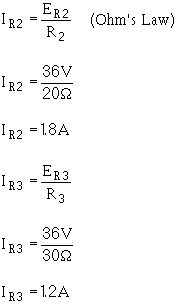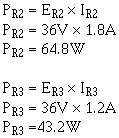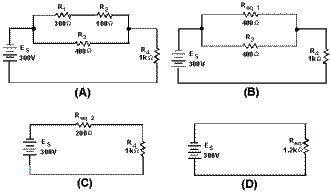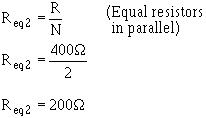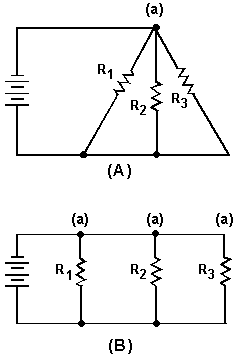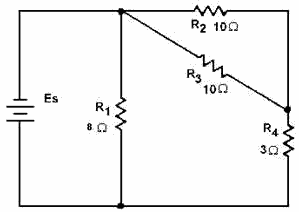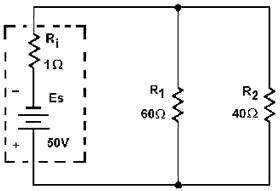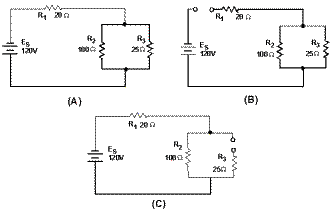Module 1 - Introduction to Matter, Energy, and Direct Current
|
||||||||||||||||||||||||||||||||||||||||||||||||||
|
Module 1 − Introduction to Matter, Energy, and Direct Current
Pages i, 1−1, 1−11, 1−21, 1−31, 1−41, 1−51, 1−61, 2−1, 2−11, 2−21, 3−1, 3−11, 3−21, 3−31, 3−41, 3−51, 3−61, 3−71, 3−81, 3−91, 3−101, 3−111, 3−121, Appendix I, II, III, IV, V, Index
To find the current through R2 and R3, refer to the original circuit, figure 3-54(A). You know ER2 and ER3 from previous calculation. Given:
Solution:
To find power used by R2 and R3, using values from previous calculations: Given:
Solution:
3-81 Now that you have solved for the unknown quantities in this circuit, you can apply what you have learned to any series, parallel, or combination circuit. It is important to remember to first look at the circuit and from observation make your determination the type circuit, what is known, and what you are looking for. A minute spent in this manner may save you many unnecessary calculations. Having computed all the currents and voltages figure 3-54, a complete description the operation the circuit can be made. The total current 3 amps leaves the negative terminal the battery and flows through the 8-ohm resistor (R1). In so doing, a voltage drop 24 volts occurs across resistor R1. At point A, this 3-ampere current divides into two currents. the total current, 1.8 amps flows through the 20-ohm resistor. The remaining current 1.2 amps flows from point A, down through the 30-ohm resistor to point B. This current produces a voltage drop 36 volts across the 30-ohm resistor. (Notice that the voltage drops across the 20- and 30-ohm resistors are the same.) The two branch currents 1.8 and 1.2 amps combine at junction B and the total current 3 amps flows back to the source. The action the circuit has been completely described with the exception power consumed, which could be described using the values previously computed. It should be pointed out that the combination circuit is not difficult to solve. The key to its solution lies in knowing the order in which the steps the solution must be accomplished. Practice Circuit Problem Figure 3-55 is a typical combination circuit. To make sure you understand the techniques solving for the unknown quantities, solve for ER1. Figure 3-55. - Combination practice circuit.
3-82 It is not necessary to solve for all the values in the circuit to compute the voltage drop across resistor R1 (E R1). First look at the circuit and determine that the values given do not provide enough information to solve for ER1 directly. If the current through R1 (IR1) is known, then ER1 can be computed by applying the formula:
The following steps will be used to solve the problem. 1. The total resistance (RT) is calculated by the use equivalent resistance. Given:
Solution:
Redraw the circuit as shown in figure 3-55(B). Given:
Solution:
Solution:
3-83 Redraw the circuit as shown in figure 3-55(C). Given:
Solution:
2. The total current (IT) is now computed. Given:
Solution:
3. Solve for the voltage dropped across Req2. This represents the voltage dropped across the network R1, R2, and R3 in the original circuit. Given:
Solution:
4. Solve for the current through Req1. (Req1 represents the network R1 and R2 in the original circuit.) Since the voltage across each branch a parallel circuit is equal to the voltage across the equivalent resistor representing the circuit: 3-84 Given:
Solution:
5. Solve for the voltage dropped across R1 (the quantity you were asked to find). Since Reqi represents the series network R1 and R2 and total current flows through each resistor in a series circuit, IR1 must equal IReq1. Given:
Solution:
Q42. Refer to figure 3-55(A). If the following resistors were replaced with the values indicated: R1 = 900, R3 = 1k , what is the total power in the circuit? What is ER2? REDRAWING Circuits for CLARITY You will notice that the schematic diagrams you have been working with have shown parallel circuits drawn as neat square figures, with each branch easily identified. In actual practice the wired circuits and more complex schematics are rarely laid out in this simple form. For this reason, it is important for you to recognize that circuits can be drawn in a variety ways, and to learn some the techniques for redrawing them into their simplified form. When a circuit is redrawn for clarity or to its simplest form, the following steps are used. i. Trace the current paths in the circuit. 2. Label the junctions in the circuit. 3. Recognize points which are at the same potential. 3-85 4. Visualize a rearrangement, "stretching" or "shrinking," connecting wires. 5. Redraw the circuit into simpler form (through stages if necessary). To redraw any circuit, start at the source, and trace the path current flow through the circuit. At points where the current divides, called JUNCTIONS, parallel branches begin. These junctions are key points reference in any circuit and should be labeled as you find them. The wires in circuit schematics are assumed to have NO Resistance and there is NO Voltage drop along any wire. This means that any unbroken wire is at the same voltage all along its length, until it is interrupted by a resistor, battery, or some other circuit component. In redrawing a circuit, a wire can be "stretched" or "shrunk" as much as you like without changing any electrical characteristic the circuit. Figure 3-56(A) is a schematic a circuit that is not drawn in the box-like fashion used in previous illustrations. To redraw this circuit, start at the voltage source and trace the path for current to the junction marked (a). At this junction the current divides into three paths. If you were to stretch the wire to show the three current paths, the circuit would appear as shown in figure 3-56(B).
Figure 3-56. - Redrawing a simple parallel circuit. While these circuits may appear to be different, the two drawings actually represent the same circuit. The drawing in figure 3-56(B) is the familiar box-like structure and may be easier to work with. Figure 3-57(A) is a schematic a circuit shown in a box-like structure, but may be misleading. This circuit in reality is a series-parallel circuit that may be redrawn as shown in figure 3-57(B). The drawing in part (B) the figure is a simpler representation the original circuit and could be reduced to just two resistors in parallel. 3-86
Figure 3-57. - Redrawing a simple series-parallel circuit. Redrawing a Complex Circuit Figure 3-58(A) shows a complex circuit that may be redrawn for clarification in the following steps. 3-87
Figure 3-58. - Redrawing a complex circuit. Note: As you redraw the circuit, draw it in simple box-like form. Each time you reach a junction, a new branch is created by stretching or shrinking the wires. Start at the negative terminal the voltage source. Current flows through R1 to a junction and divides into three paths; label this junction (a). Follow one the paths current through R2 and R3 to a junction where the current divides into two more paths. This junction is labeled (b). The current through one branch this junction goes through R5 and back to the source. (The most direct path.) Now that you have completed a path for current to the source, return to the last junction, (b). Follow current through the other branch from this junction. Current flows from junction (b) through R4 to the source. All the paths from junction (b) have been traced. Only one path from junction (a) has been completed. You must now return to junction (a) to complete the other two paths. From junction (a) the current flows through R7 back to the source. (There are no additional branches on this path.) Return to junction (a) to trace the third path from this junction. Current flows through R6 and R8 and comes to a junction. Label this junction (c). From junction (c) one path for current is through R9 to the source. The other path for current from junction (c) is through R10 to the source. All the junctions in this circuit have 3-88 now been labeled. The circuit and the junction can be redrawn as shown in figure 3-58(C). It is much easier to recognize the series and parallel paths in the redrawn circuit. Q43. What is the total resistance the circuit shown in figure 3-59? (Hint: Redraw the circuit to simplify and then use equivalent resistances to compute for RT.)
Figure 3-59. - Simplification circuit problem. Q44. What is the total resistance the circuit shown in figure 3-60?
Figure 3-60. - Source resistance in a parallel circuit. Q45. What effect does the internal resistance have on the rest the circuit shown in figure 3-60? EFFECTS OPEN and Short Circuits Earlier in this chapter the terms open and short circuits were discussed. The following discussion deals with the effects on a circuit when an open or a short occurs. 3-89 The major difference between an open in a parallel circuit and an open in a series circuit is that in the parallel circuit the open would not necessarily disable the circuit. If the open condition occurs in a series portion the circuit, there will be no current because there is no complete path for current flow. If, on the other hand, the open occurs in a parallel path, some current will still flow in the circuit. The parallel branch where the open occurs will be effectively disabled, total resistance the circuit will INCREASE, and total current will DECREASE. To clarify these points, figure 3-61 illustrates a series parallel circuit. First the effect an open in the series portion this circuit will be examined. Figure 3-61(A) shows the normal circuit, RT = 40 ohms and IT = 3 amps. In figure 3-61(B) an open is shown in the series portion the circuit, there is no complete path for current and the resistance the circuit is considered to be infinite.
Figure 3-61. - Series-parallel circuit with opens. In figure 3-61(C) an open is shown in the parallel branch R3. There is no path for current through R3. In the circuit, current flows through R1 and R2 only. Since there is only one path for current flow, R1 and R2 are effectively in series. Under these conditions RT = 120 and IT = 1 amp. As you can see, when an open occurs in a parallel branch, total circuit resistance increases and total circuit current decreases. A short circuit in a parallel network has an effect similar to a short in a series circuit. In general, the short will cause an increase in current and the possibility component damage regardless the type 3-90
|
||||||||||||||||||||||||||||||||||||||||||||||||||

